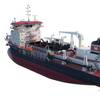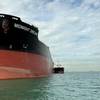The 140 x 46 ft. ferry vessel, Shirley Irene, was constructed in 1991 on the Gulf Coast, for operation in Lake Erie, out of Marblehead, Ohio. The original design concept was conceived by DeJong & Lebet, Inc., Jacksonville, Fla., and Ed von Bergen. The owner's requirements were for an inexpensive, open-deck vehicle ferry, with a high degree of maneuverability, for local wind and other weather conditions, along with double-ended capability. Simplicity of operation was also important. The owner also required some increased protection for the exposed vehicles on the open deck.
There were several design considerations, which ultimately determined the final vessel configuration. Most of these related to the maneuverability and thus, the propulsion system of the vessel. However, several other design considerations affected the direction of this design. These included route, draft restrictions and the owner's requirement for an ABS classed vessel.
The ferry was originally designed with two steerable propulsion systems; one to be located forward-Port, and one aft-Starboard. This was later changed to four units, in order to provide better maneuverability in the high wind conditions in which the ferry would operate. The ferry was expected to operate in Lake Erie during the severe weather of winter months on an exposed waters route.
The ferry was given extra power to accomplish this. A normal vehicle ferry of this size would be powered by half the propulsion as Shirley Irene. This vessel is powered by four 3406 TA Caterpillar diesel engines, developing 365 hp @ 1,800 rpm. Schottel Z-drives were chosen for their excellent reputation for reliability.
The propulsion units forward were tied together on one steering unit, as were the aft ones. This is fairly standard in this type of design, where operation of four units independently would be difficult for the operator.
As a cost-saving measure, the vessel's engines were equipped with Twin Disc PTOs instead of marine gears, since the reverse function was not required.
A torsional analysis of the propulsion system indicated a torsional vibration damper would be required to protect the Z-drives. This gets quite expensive when multiplied by four.
In order to provide for easy maintenance of the Z-drives, they were installed in bolt-in wells, where the bolting flange is above the waterline. This allows a Z-drive unit to be removed with the vessel in the water through the soft patches in the weather deck above.
The owner was concerned about the severe weather environment in which the vessel would operate. Some extra protection in this regard is built into the design. Bulwarks were raised to a height of six ft. in the forward and aft 20 percent of the vessel. The boarding ramp was even higher than that, providing additional protection. The hull depth was also increased over an earlier similar design which operated in less severe weather. This provided the added protection of 18-24 in. of additional freeboard.
The owner felt the reliability and toughness of the vessel would be further increased by ABS Classification. This required several cost and equipment additions to the vessel. The owner felt these additions were justified by the expected increase in toughness and reliability. Some of the additional items required by ABS Classification were:
· Material and equipment inspection
· Larger bilge and fire system
· CO2 systems in the engine rooms
· Dogged doors in the deckhouse and pilothouse
· Ball check valves on vent pipes
· ABS plan review and inspection fees.
Hull Design
Due to draft restrictions, the Z-drives were mounted in hull recesses, with sloped sides to maintain efficient thrust. The Z-drives did extend beyond the hull bottom, and were protected by a two ft. deep keel.
The vessel's hull was simply constructed with a parallel mid-body, with fairly fine "riverboat"-type bows on each end. This allowed for an efficient hull form, that was easy to build and provided some flair in the forward sections to break up the seas
The hull was framed transversely, and was quite strongly built, due to the many internal bulkheads required to maintain a gross tonnage of less than 100 gt. This was required since the vessel was USCG-certified under Subchapter "T." Additional strength was built into the main deck to accommodate the heavy loads of construction equipment and heavy commercial vehicles.
Certification
In addition to ABS Classification, the vessel is USCG certified under Subchapter "T." This was important for the owner, since most of his marine personnel were licensed for this class of vessel. Subchapter "T" also resulted in simpler systems and vessel operation.
The vessel is certified to carry various combinations of cars, trucks, busses and passengers on exposed waters. Although the stability is satisfactory for 400 passengers, the vessel is normally limited to 150 passengers due to structural fire protection considerations. The vessel frequently carries heavy loads of construction equipment, and has a maximum payload of 320,000 lbs.
"Keep it simple" construction allowed the owner to spend extra money where he needed it - namely the propulsion/maneuvering system and added reliability of ABS Classification.-Andy Lebet
Subscribe for
Maritime Reporter E-News
Maritime Reporter E-News is the maritime industry's largest circulation and most authoritative ENews Service, delivered to your Email five times per week










